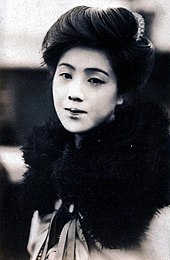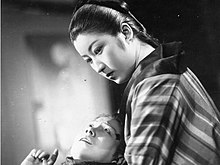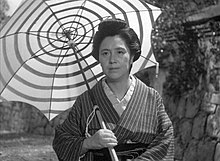Urabe Kumeko
Urabe Kumeko , born as Kimura Kume ( Japanese 浦 辺 粂 子Urabe Kumeko; born October 5, 1902 in Kamo District of Shizuoka Prefecture ; died October 26, 1989 in Shinjuku ), also used the stage names Kumeko Ichijo , Toyama Midori , Chidori Shizuura and Chidori Toyama. She worked on stage as well as on television and film. In 1919 she left school and joined a theater troupe, with whom she appeared under various stage names as an actress and dancer. In 1923 she auditioned at the Nikkatsu film studio and took on the name Urabe Kumeko, by which she was known for the rest of her life. She appeared in her first film the following year and continued to play until 1987. She has worked with directors such as Kenji Mizoguchi and Mikio Naruse and has starred in over 150 films, including Older Brother, Younger Sister and She Was Like a Wild Chrysanthemum . She also starred in Japanese television dramas, including thirteen episodes of Toshiba Sunday Theater between 1958 and 1980. In the following decade, she made a name for herself as a Japanese grandmother idol .
biography
Early years
Kimura Kume (Japanese木村 く め) was born on October 5, 1902 as the daughter of Hana Kume and Keichu Kume, a Rinzai school priest at Kenchō-ji . She grew up as an only child in the rural area of Kamo District, Shizuoka Kamo. An older brother died at a young age. In 1909 the family moved to Kawazu, Shizuoka Kawazu, also in Shizuoka Prefecture, and Kume attended elementary school there. In 1915 they moved again, this time to Numazu , where their father served at the Myōshin-ji temple and Kume completed her schooling at the Numazu Girls' School two years later. During this time, her interest in acting was piqued when she saw Rensageki , a mixture of silent film and stage play. In 1919 she left school and joined Yasuyoshi Suzuki's troupe , taking the stage name Kumeko Ichijo.
Over the next four years, Kume joined traveling theaters and opera troupes, perfecting her singing and dancing practices, and learning to play many roles. She also took on a number of stage names and was known as Toyama Midori , Chidori Shizuura, and Chidori Toyama . During this time she also got to know Chieko Saga . The girlfriends came to be known as Sagachi and Tochi .
Film career
In August 1923, Yasumasa Hatano recommended that she audition at the Nikkatsu film studio . She was successful and adopted the stage name Kumeko Urabe , which she proudly kept for the rest of her career. She resisted being awarded the Japanese Medal of Honor under her maiden name , as this award was intended for the work of Kumeko Urabe. She had her first film appearance in 1924 when she played the heroine in the film Seisaku's wife (Japanese清 作 の 妻). She was one of the first actresses in Japanese cinema. Her skills caught the attention of director Kenji Mizoguchi , who let her play alongside Denmei Suzuki in the film Dust Boundary (jap.塵境). After that, Urabe became one of the most popular members of the studio, surpassed only by Yoneko Sakai and Haruko Sawamura .
On October 23, 1928, she married Koichi Ueno, the son of a wealthy man from Kyoto , and left the studio. The marriage was divorced in April 1930. Urabe returned to acting and appeared in Mizoguchi 's next film, Tojin Okichi (Japanese唐人 お 吉). In July 1933, she left the studio and moved to Shinkō Kinema , which was renamed Daiei Film in 1942 . After World War II , she continued to star in films, including Lightning (Japanese稲 妻) and Older Brother, Younger Sister (あ に い も う と), directed by Mikio Naruse .
Television career
Kumeko Urabe expanded her repertoire through appearances in Japanese television plays, first in the 1957 and 1959 episodes of There Are People Here . Mainly grandmothers, she played in various shows, including Sharp Tuesday Theater and Toshiba Sunday Theater . In the latter case, she appeared in a total of thirteen episodes between 1958 and 1980, most recently in the 1228th episode entitled Song of Thoughts (Japanese想 思 樹 の 歌).
After 1980, Urabe increasingly found roles as a grandmother idol . In November 1984 she released a music single called I Became a Singer (Japaneseわ た し 歌手 に な り ま し た よ). This career ended tragically in 1989 when her yukata caught fire on the gas stove while boiling water in her apartment and she was seriously burned. Urabe was taken to the Tokyo Medical University Hospital in Nishi-Shinjuku , where she died of serious injuries the next day at the age of 87. She had received a number of awards throughout her life, including the 1966 Medal of Honor with a Purple Ribbon. In her spare time she enjoyed playing mahjong and betting on keirin and boat races.
Filmography
Movies
Urabe starred in over 320 films including:
- Seisaku's Wife (Japanese清 作 の 妻), 1924, Come.
- Dust Boundary (jap.塵境), 1924, Omatsu.
- A Women Who Longs for the Law (Japanese法 を 慕 ふ 女), 1925, Yuriko.
- Dolls House (Japanese人形 の 家), 1927, Miyako Hayashida.
- Tojin Okichi (Japanese唐人 お 吉), 1930, Omatsu.
- The Water Magician (Japanese瀧 の 白 糸), 1933, Ogin.
- Messenger from the Moon (Japanese月 よ り の 使者), 1934, Jailer.
- The Lieutenant's daughter (Japanese大尉 の 娘), 1936, Yutaka.
- Kindness (jap.新 雪), 1942, Kinbe's wife.
- Genghis Khan (jap.成吉思汗), 1943, Weruenke.
- Women of the Night (Japanese夜 の 女 た ち), 1948, Aunt of pimp.
- Foreign Hill (Japanese異国 の 丘), 1949, Mother-in-law.
- Ginza Kankan Museum (Japanese銀座 カ ン カ ン 娘), 1949, Odai.
- Mrs Pearl (jap.真珠 夫人) 1950, Aunt Karasawa and Otami.
- Marriage March (Japanese結婚 行進 曲), 1951, Auntie.
- Steamed Rice (jap. / め し), 1951, Shige Taniguchi.
- Lightning (Japanese稲 妻), 1952, Osamu.
- Where Chimneys Are Seen (Japanese煙 突 の 見 え る 場所), 1953, Kayo Nojima.
- Older Brother, Younger Sister (Japaneseあ に い も う と), 1953, Riki.
- Twenty-Four Eyes (Japanese二十 四 の 瞳), 1954, Teacher's wife.
- Somewhere Under the Broad Sky (Japaneseこ の 広 い 空 の ど こ か に), 1954, Shige.
- She Was Like a Wild Chrysanthemum (Japanese野菊 の 如 き 君 な り き), 1955, Minko's grandmother.
- The Magistrate (Japanese次男 坊 判官), 1955, Shige.
- Red Light District (Japanese赤 線 地 帯), 1956, OTane.
- Unforgettable Affection (Japanese忘 れ え ぬ 慕 情), 1956, Fujita.
- I Knew the Cat (Japanese猫 は 知 っ て い た), 1958, Chie Kuwata.
- The Eternal Rainbow (jap.こ の 天 の 虹), 1958, Osamu's mother.
- Irohanihehe (Japaneseい ろ は に ほ へ と), 1960, Mine Matsumoto.
- Japanese Grandma: A Comedy (Japanese喜劇 に っ ぽ ん の お 婆 あ ち ゃ ん),
- Being Two Isn't Easy (Japanese私 は 二 歳), 1962, Ino.
- Crazy Movie: Irresponsible Japanese Guy (Japaneseク レ ー ジ ー 映 画 ニ ッ ポ ン 無 責任 野 郎), 1962, Ume Nakagome.
- Yearning (Japanese乱 れ る), 1964, Onsen no Okami
- Hit and Run (Japaneseひ き 逃 げ), 1966, Hisako Kanematsu.
- Happiness to You, Sentimental boy (Japanese君 に 幸 せ お セ ン チ 面 他 l 簿 y ), 1967, Kura Ninotani.
- Two in Shadow (Japanese乱 れ 雲). 1967. Mishima Nui.
- Sun on a Solitary Island (Japanese孤島 の 太陽), 1968, Oume.
- Crazy Movie: Mexican Free for All (Japaneseク レ ー ジ ー 映 画 ク レ ー ジ ー ー メ キ シ コ 大作 戦), 1968, Ume Suzuki.
- Ecstatic Person (Japanese恍惚 の 人), 1973, Grandma Kadoya.
- Shinano River (Japaneseし な の 川), 1973, Mother.
- The Life of Chikuzan (Japanese竹山 ひ と り 旅), 1977, Daikoku of the Temple.
- Before Spring (Japanese海潮音), 1980, Ushima Zuyo.
- Lonely Heart (Japaneseさ び し ん ぼ う), 1985, Fuki Inoue.
- Eight Stories (Japaneseハ チ 公 物語), 1987, Mrs. Uchigi.
German speaking
- Really Live Once (Ikiru), 1952
- Early Spring (Soshun), 1956
- Your Body (Ratai), 1962
TV
Urabe has appeared in over 100 TV episodes including:
- NHK - There Are People Here (Japaneseこ こ に 人 あ り)
- Episodes 26 & 27 "House of Others" (Japanese他人 の 家), 1957
- Episode 77 "Interrupting the Wall" (Japanese壁 さ え ぎ る と も), 1959.
- Tokyo Broadcasting System KRT / TBS - Toshiba Sunday Theater (Japanese東芝 日 曜 劇場) 13 episodes including:
- 91 "Oki Letter" (Japanese置 手紙), 1958
- 416 Father and Son (Japanese父 と 子 た ち), 1964
- 890 "Spring Wife" (Japanese妻 の 春), 1973
- 1228 "Song of Thoughts" (Japanese想 思 樹 の 歌), 1980.
- Fuji TVCX - Sharp Tuesday Theater (Japaneseシ ャ ー プ 火 曜 劇場) "Like Nogiku" (Japanese野菊 の 如 く), 1961.
- TBS - Keisuke Kinoshita Hour (Japanese木 下 恵 介 ア ワ ー) "Memorial Tree" (Japanese記念 樹), 1966.
- NTV - Anxious Wife (Japanese気 に な る 嫁 さ ん), 1971.
- TBS - When Hamanasu Flowers Bloom (Japaneseは ま な す の 花 が 咲 い た ら), 1981–1982.
- NTV - Female Lawyer Ayuko Takabayashi: 4 Shinshu Iida Line Tenryukyo Gorge (Japanese女 弁 護士 ・ 高 林 鮎 子 4 信 州 飯 田 線 殺 意 の 天 竜 峡), 1988.
Publications
Urabe also authored several books about her acting career:
- 映 画 女優 の 半生( Eiga joyū no hansei ; translated: "Half-life of a film actress") Tokyo: Tokyo Engei Tsūshinsha, 1925 OCLC 672573354 (Japanese)
- 浦 辺 粂 子 の あ た し ゃ 女優 で す よ( Urabe kumeko no atasha joyū desuyo ; translated: "I, the actress Kumeko Urabe") Tokyo: Shikai Shobō, 1985, ISBN 978-4-91562-901-3 . (Japanese)
- 映 画 道 中 無 我 夢中: 浦 辺 粂 子 の 女優 一代 記( Eiga dōchū muga muchū: Urabe Kumeko no joyū ichidaiki ; translated: "Crazy about film: The autobiography of the actress Kumeko Urabe") Tokyo: Kawade Shobō Shinsha, 1985, ISBN 978-4 -30900-412-9 . (Japanese)
literature
- Nichigai Asoshiētsu: (Japanese映 画 基本 書目 大 正 ・ 昭和 ・ 平 成) (Basic film book) Hatsubaimoto Kinokuniya Shoten Taisho, Tokyo, 2008, ISBN 978-4-81692-194-0 . (Japanese)
- Peter Cowie, Derek Elley: World Filmography 1967. Tantivy Press, London 1977, ISBN 978-0-49801-565-6 . (English)
- AV Ekusupuresu: (Japanese映 画 大 全集) (film guide) Metamoru Shuppan, Tokyo 1998, ISBN 978-4-89595-216-3 . (Japanese)
- Katsuhito Inomata: (Japanese日本 映 画 名作 全 史) (Complete story of Japanese masterpieces in film) Shakai Shisōsha, Tokyo 1975, ISBN 978-4-39010-803-4 . (Japanese)
- Kenji Iwamoto: (Japaneseサ イ レ ン ト か ら ト ー キ ー へ: 日本 映 画 形成 期 の 人 と 文化) (From silent films to talkies , people and culture in the age of Japanese film education), Shinwasha Tokyo 2007, ISBN 978-4-91608-778-2 . (Japanese)
- Musei Eiga Kanshōkai, Matsuda Eigasha: (Japanese日本 無声 映 画 俳 優 名 鑑) (The great Japanese silent film stars), Āban Konekushonzu Tokyo 2005, ISBN 978-4-90084-975-4 .
- Kinema Junpōsha: (Japanese日本 映 画 俳 優 全集 ・ 女優 編) (Complete works of Japanese film actors and actresses), Tokyo 1980 (Japanese)
- Kōzō Matsūra: (Japanese日本 映 画 史 大 鑑: 映 画 渡 来 か ら 現代 ま で ・ 86 年 間 の 記錄) (Encyclopedia of Japanese Film History: A record of the 86 years from the arrival of the film to the present day) Bunka Shuppankyoku, Japanese. Tokyo 1982 (Japanese. Tokyo 1982 )
- Kenshu Miyagi (Japanese戦 後 ・ 戦 争 映 画 史) (wartime and post-war period) Tanteki Chokusanbō, Okinawa 1990, ISBN 978-4-88218-034-0 . (Japanese)
- Donald Richie: A Hundred Years of Japanese Film. Kodansha Tokyo 2006, ISBN 978-4-77002-995-9 .
- Nyūsu Tsūshinsha (Japanese.テ レ ビ ド ラ マ 全 史) (The History of the Television Game, 1953–1994) Tōkyō Nyūsu Tsūshinsha, Tokyo 1994 (Japanese)
Web links
- Urabe Kumeko in the Internet Movie Database (English)
Individual evidence
- ↑ Kinema Junpōsha, p. 16
- ↑ Kinema Junpōsha日本 映 画 俳 優 全集 ・ 女優 編Complete Works of Japanese Film Actors and Actresses . Japan 1980 (Japanese).
- ↑ Kinema Junpōsha, p. 17
- ↑ Kinema Junpōsha日本 映 画 俳 優 全集 ・ 女優 編Complete Works of Japanese Film Actors and Actresses . Japan 1980 (Japanese).
- ↑ Kinema Junpōsha, p. 18
- ↑ Richie, p. 77
- ↑ a b Matsūra, p. 86
- ↑ a b Kinema Junpōsha, p. 19
- ↑ a b Tsūshinsha, p. 58
- ↑ a b c Tsūshinsha, p. 348
- ↑ “お ば あ ち ゃ ん ア イ ド ル” の 浦 辺 粂 子 浴衣 に 引火 し 火 傷 死. In: nikkan-gendai-com . June 20, 2018. Archived from the original on April 10, 2021.
- ↑ Kanshōkai, p. 172
- ↑ Inomata, p. 294
- ↑ Inomata, p. 52
- ↑ Asoshiētsu, p. 108
- ↑ Kinema Junpōsha, p. 383
- ↑ Inomata, p. 454
- ↑ Matsuura, page 75
- ^ Inomata, p. 86
- ↑ Matsura, p 213
- ↑ Inomata, p. 471
- ↑ a b Miyagi, p. 35
- ↑ Matsuura, p 140
- ↑ Kanshōkai, p. 26
- ↑ a b Inomata, p. 473
- ↑ Matsuura, p 150
- ↑ a b Inomata, p. 495
- ↑ Matsuura, p 157
- ↑ Kinema Junpōsha, p. 801
- ↑ Ekusupuresu, p. 1156
- ↑ Matsura, p 158
- ↑ Ekusupuresu, p. 1082
- ↑ Ekusupuresu, p. 975
- ↑ Ekusupuresu, p. 878
- ↑ a b c Ekusupuresu, p. 1088
- ↑ Inomata, p. 478
- ↑ Kanshōkai, p. 309
- ↑ CowiemElley 1977, p. 386
- ↑ CowiemElley 1977, p. 383
- ↑ Matsuura, p 159
- ↑ Ekusupuresu, p. 953
- ↑ Inomata, p. 48
- ↑ Matsuura, p 197
- ↑ Ekusupuresu, p. 916
- ↑ Kinema Junpōsha, p. 21
- ↑ Kinema Junpōsha, p. 86
- ↑ Ekusupuresu, p. 1108
- ↑ Tsūshinsha, p. 80
- ↑ Tsūshinsha, p. 93
- ↑ Tsūshinsha, p. 363
- ↑ Tsūshinsha, p. 522
- ↑ Asoshiētsu, p. 239
| personal data | |
|---|---|
| SURNAME | Urabe, Kumeko |
| ALTERNATIVE NAMES | Kumeko Ichijo; Toyama Midori; Chidori Shizuura; Chidori Toyama |
| BRIEF DESCRIPTION | japanese actress |
| BIRTH DATE | October 5, 1902 |
| PLACE OF BIRTH | Kamo District, Shizuoka Prefecture |
| DATE OF DEATH | October 26, 1989 |
| PLACE OF DEATH | Shinjuku |



